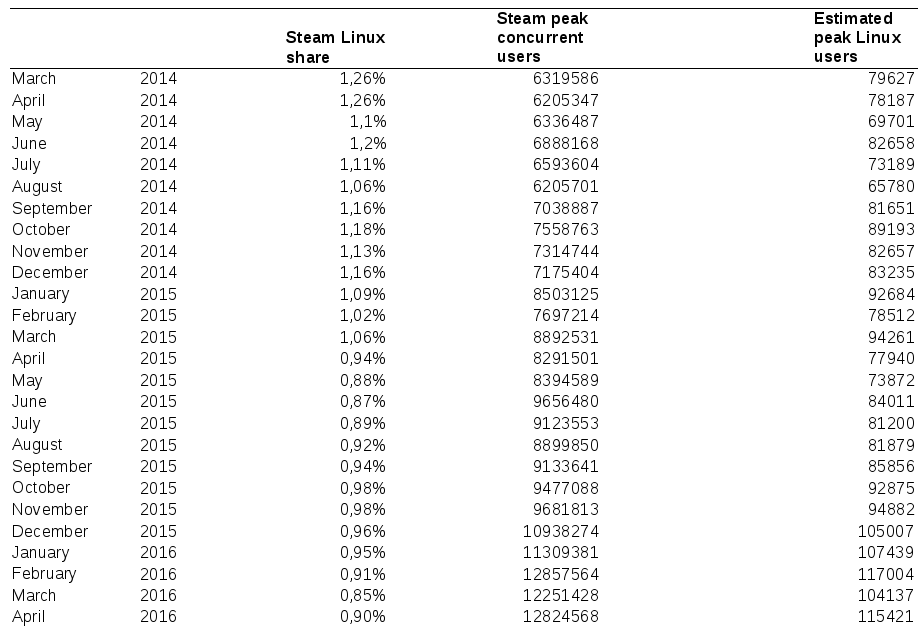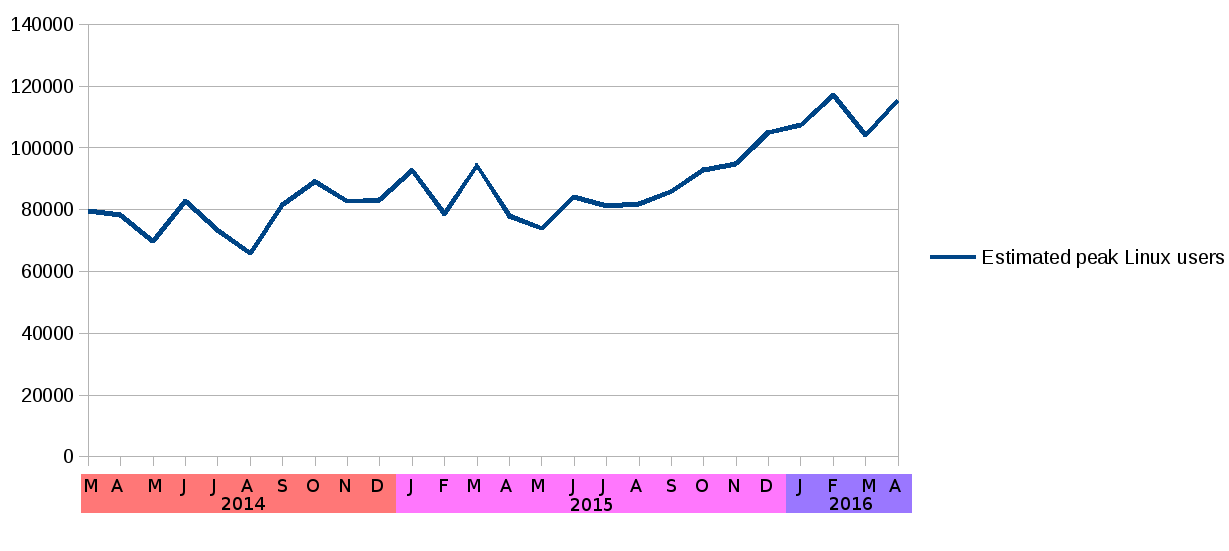Now that the monthly Steam statistics are out again, we can see that the result has increased slightly from last month, we are back up to 0.90% from 0.85%. While that is a positive sign, we are again looking at a number below 1% this month.
As has been previously pointed out there are a few flaws with the Steam statistics, such as that users of the Big Picture Mode do not get the survey at all. There are also likely a few flaws we don't know about. Still, we can safely assume that the Steam Hardware Survey isn't completely lying either: Linux usage might be off by a bit, but if it says below 1%, it is rather unlikely that the real numbers are for example above 2%. It is a statistic, and we have to treat it like a statistic, that gives us an indication of the Linux market share on Steam. An increase likely means a larger market share and a decrease a smaller market share.
A fair point that has been made, however, is that the amount of Steam users has been increasing over time. Therefore, it is reasonable to assume the number of Linux Steam users has increased as well. The question is: How did Steam grow?
A number that is often mentioned is that Steam had 125 million active users in February 2015. The problem with this number is that we don't have any more recent data, which makes it difficult to back claims that Linux game usage did increase. We really need data about Steam growth to say anything meaningful about the growth of Linux gaming on Steam.
This question was wandering around in my head for a while until I got an idea: Steam reports the peak concurrent users each day. This number would be a good an indication of the size of Steam, be it not for the fact that Steam only displays the number of the last day. The solution to this is the Wayback Machine. Using the Wayback Machine we can see archived copies of the Steam statistics page and therefore reconstruct the growth of Steam over the years. It also allows us to see the Steam Linux market share in past surveys. Luck is that the Wayback Machine archives the Steam statistics quite often so there is a lot of data available.
I have collected the data from March 2014 to April 2016, taking a sample around the 20th of each month, and used it to estimate the peak concurrent Linux users on Steam, by multiplying the peak concurrent users with the Linux share. Then you get these results:

Making a graph, we have a nice visualization of the growth of Linux gaming on Steam:

What we can now see, and this information is probably revealed for the first time, is that Linux use did largely remain flat until halfway through 2015. But since then, Linux gaming is in a steady growth trend!
Now is this a good or a bad thing? The good news is that we are growing and the growth seems steady. This is probably why professional game porters like Virtual Programming and Feral Interactive are doing well: Their market is increasing. As these companies generally port games that have already proven themselves, they are likely looking at increasing turnover.
However, it is also clear we are growing slower than the rest of Steam, and this is a point of concern. Why? The faster Steam grows, the more games there will be available (and in fact the number of games released monthly on Steam has grown during the last years). Our money will be spread over more games and if we were already insignificant, we will be even more insignificant for game developers. Numbers below 1% *are* pretty bad, there is no way to deny this.
However, the real question is what this will mean for the future: Steam has grown a lot. If Steam had 125 million users in February 2015, it should now have 185 million users. Will Steam be able to maintain this growth? If Steam maintains the current growth, it would need 270 million users halfway next year. I think this is rather unlikely, because you can already fit the entire population of a lot of countries in 185 million people, let alone 270 million.
Such an increase would be slightly more than the entire population of a big country like Germany joining Steam. I can't believe that. There are a limited number of Windows gamers and therefore the amount of potential Steam Windows users are not unlimited. Also, quite important is that competition for Steam is increasing, for example from the Windows store, but also from other publishers who want their own stores.
Therefore I assume that Steam Windows growth will stall at some point during 2016. But Steam Linux growth? There is a still a lot of potential for people switching to Linux, there is a lot less competition, and especially important, with initiatives like Steam Machines, the number of potential Steam Linux users has increased a lot. Therefore, when Steam growth stalls, because we have some momentum, we will have a lot of opportunity to catch up.
Conclusion: The statistics say that we haven't seen the best of Linux gaming yet, not by far.
As has been previously pointed out there are a few flaws with the Steam statistics, such as that users of the Big Picture Mode do not get the survey at all. There are also likely a few flaws we don't know about. Still, we can safely assume that the Steam Hardware Survey isn't completely lying either: Linux usage might be off by a bit, but if it says below 1%, it is rather unlikely that the real numbers are for example above 2%. It is a statistic, and we have to treat it like a statistic, that gives us an indication of the Linux market share on Steam. An increase likely means a larger market share and a decrease a smaller market share.
A fair point that has been made, however, is that the amount of Steam users has been increasing over time. Therefore, it is reasonable to assume the number of Linux Steam users has increased as well. The question is: How did Steam grow?
A number that is often mentioned is that Steam had 125 million active users in February 2015. The problem with this number is that we don't have any more recent data, which makes it difficult to back claims that Linux game usage did increase. We really need data about Steam growth to say anything meaningful about the growth of Linux gaming on Steam.
This question was wandering around in my head for a while until I got an idea: Steam reports the peak concurrent users each day. This number would be a good an indication of the size of Steam, be it not for the fact that Steam only displays the number of the last day. The solution to this is the Wayback Machine. Using the Wayback Machine we can see archived copies of the Steam statistics page and therefore reconstruct the growth of Steam over the years. It also allows us to see the Steam Linux market share in past surveys. Luck is that the Wayback Machine archives the Steam statistics quite often so there is a lot of data available.
I have collected the data from March 2014 to April 2016, taking a sample around the 20th of each month, and used it to estimate the peak concurrent Linux users on Steam, by multiplying the peak concurrent users with the Linux share. Then you get these results:

Making a graph, we have a nice visualization of the growth of Linux gaming on Steam:

What we can now see, and this information is probably revealed for the first time, is that Linux use did largely remain flat until halfway through 2015. But since then, Linux gaming is in a steady growth trend!
Now is this a good or a bad thing? The good news is that we are growing and the growth seems steady. This is probably why professional game porters like Virtual Programming and Feral Interactive are doing well: Their market is increasing. As these companies generally port games that have already proven themselves, they are likely looking at increasing turnover.
However, it is also clear we are growing slower than the rest of Steam, and this is a point of concern. Why? The faster Steam grows, the more games there will be available (and in fact the number of games released monthly on Steam has grown during the last years). Our money will be spread over more games and if we were already insignificant, we will be even more insignificant for game developers. Numbers below 1% *are* pretty bad, there is no way to deny this.
However, the real question is what this will mean for the future: Steam has grown a lot. If Steam had 125 million users in February 2015, it should now have 185 million users. Will Steam be able to maintain this growth? If Steam maintains the current growth, it would need 270 million users halfway next year. I think this is rather unlikely, because you can already fit the entire population of a lot of countries in 185 million people, let alone 270 million.
Such an increase would be slightly more than the entire population of a big country like Germany joining Steam. I can't believe that. There are a limited number of Windows gamers and therefore the amount of potential Steam Windows users are not unlimited. Also, quite important is that competition for Steam is increasing, for example from the Windows store, but also from other publishers who want their own stores.
Therefore I assume that Steam Windows growth will stall at some point during 2016. But Steam Linux growth? There is a still a lot of potential for people switching to Linux, there is a lot less competition, and especially important, with initiatives like Steam Machines, the number of potential Steam Linux users has increased a lot. Therefore, when Steam growth stalls, because we have some momentum, we will have a lot of opportunity to catch up.
Conclusion: The statistics say that we haven't seen the best of Linux gaming yet, not by far.
Some you may have missed, popular articles from the last month:
All posts need to follow our rules. For users logged in: please hit the Report Flag icon on any post that breaks the rules or contains illegal / harmful content. Guest readers can email us for any issues.




 How to set, change and reset your SteamOS / Steam Deck desktop sudo password
How to set, change and reset your SteamOS / Steam Deck desktop sudo password How to set up Decky Loader on Steam Deck / SteamOS for easy plugins
How to set up Decky Loader on Steam Deck / SteamOS for easy plugins
Me too. And already has a year and a half I'm using Steam on Linux.
PS: I never got the survey for Linux either. I am often getting it for Windows when I boot that to play MMOs (most of which don't even use Steam)...
Last edited by Nyamiou on 2 May 2016 at 9:09 pm UTC
I've got a question about it... I don't know how the peak of concurrent users number was taken, but if it was taken the same day the Steam statistics went out, we might have a problem here.
I'm pretty sure that if we display the curves of the peaks of concurrent users overtime, we would not see a straight line, but a bumpy one, depending on the day in the week. Meaning that if the statistics came out on a Sunday, the 1% of it would be quite different than during some day in the middle of the week.
So if it's not the case, it might be better to do an average of the peaks around the day where the statistics came out.
I agree that the number of Linux users doesn't matter and that the top 10 games has an influence of the real number of Linux users, but the trend is still interesting to see. It's a bit like distrowatch: we know it's not the real numbers, but the protocol is the same since so much time, that you can extract trends from the curves.
An excellent point. I wonder how many of the steam users just play Dota, Counter Strike, or Team Fortress and absolutely nothing else.
I was in fact wondering why so many games continue to get ported to Linux even though all indications show 1~2% market share!
The Wayback Machine does not archive the Steam Statistics page daily. I took the closest archive date to the 20th of each month. So yes, it is possible that there is some noise due to a differing number of users during a week.
The publishers / developers are simply not interested in just "how many people use which OS". That's in fact too less information for game development, especially for bigger titles considering the system requirements. They need the information about how many users use which OS and which graphics cards to see their potential target market. If 90 % (in example) of the linux steam users use Intel drivers, I can see why we're not given so much love. On the other hand, since Feral etc. are mainly betting on NVidia, I'm pretty sure the majority of linux gamers runs NV cards.
Of course valve knows how many users use linux, and even if it's 5 %, the number is completely irrelevant for developers/publishers unless they run that on gaming rigs which are strong enough for their games, making them a target audience. So probably the target audience for bigger games is way below even that 1 %.
Current number of players and number of active Steam Users are probably correlated, but in no way linear.
Essentially, the conclusion that linux users are growing slower then steam itself are directly taken from the steam-survey percentage. Nothing new learned.